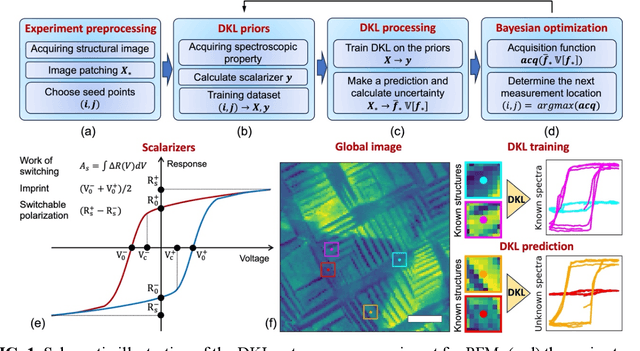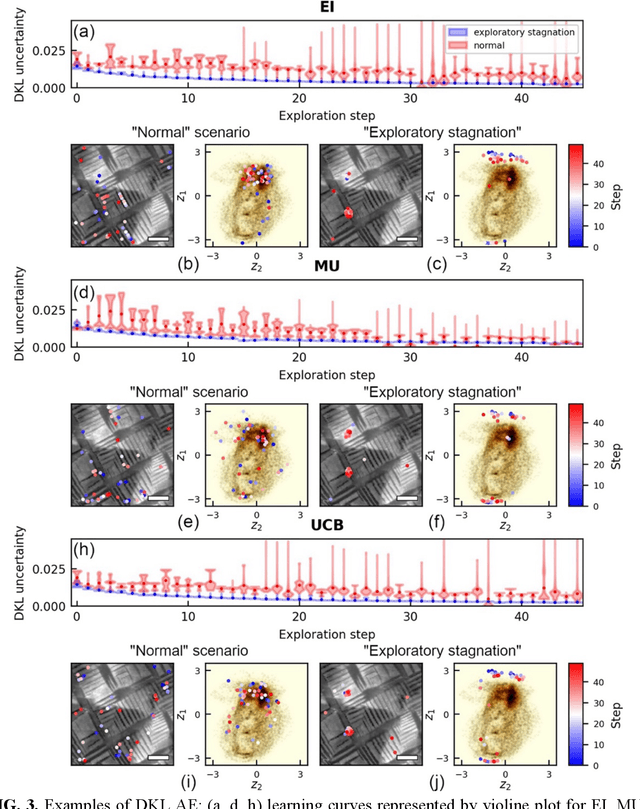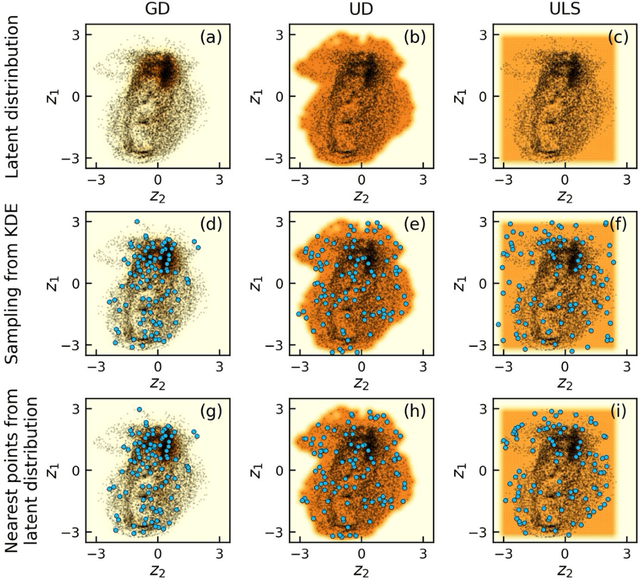Hiroshi Funakubo
Domain Switching on the Pareto Front: Multi-Objective Deep Kernel Learning in Automated Piezoresponse Force Microscopy
Jun 09, 2025Abstract:Ferroelectric polarization switching underpins the functional performance of a wide range of materials and devices, yet its dependence on complex local microstructural features renders systematic exploration by manual or grid-based spectroscopic measurements impractical. Here, we introduce a multi-objective kernel-learning workflow that infers the microstructural rules governing switching behavior directly from high-resolution imaging data. Applied to automated piezoresponse force microscopy (PFM) experiments, our framework efficiently identifies the key relationships between domain-wall configurations and local switching kinetics, revealing how specific wall geometries and defect distributions modulate polarization reversal. Post-experiment analysis projects abstract reward functions, such as switching ease and domain symmetry, onto physically interpretable descriptors including domain configuration and proximity to boundaries. This enables not only high-throughput active learning, but also mechanistic insight into the microstructural control of switching phenomena. While demonstrated for ferroelectric domain switching, our approach provides a powerful, generalizable tool for navigating complex, non-differentiable design spaces, from structure-property correlations in molecular discovery to combinatorial optimization across diverse imaging modalities.
Exploring Domain Wall Pinning in Ferroelectrics via Automated High Throughput AFM
May 29, 2025Abstract:Domain-wall dynamics in ferroelectric materials are strongly position-dependent since each polar interface is locked into a unique local microstructure. This necessitates spatially resolved studies of the wall-pinning using scanning-probe microscopy techniques. The pinning centers and preexisting domain walls are usually sparse within image plane, precluding the use of dense hyperspectral imaging modes and requiring time-consuming human experimentation. Here, a large area epitaxial PbTiO$_3$ film on cubic KTaO$_3$ were investigated to quantify the electric field driven dynamics of the polar-strain domain structures using ML-controlled automated Piezoresponse Force Microscopy. Analysis of 1500 switching events reveals that domain wall displacement depends not only on field parameters but also on the local ferroelectric-ferroelastic configuration. For example, twin boundaries in polydomains regions like a$_1^-$/$c^+$ $\parallel$ a$_2^-$/$c^-$ stay pinned up to a certain level of bias magnitude and change only marginally as the bias increases from 20V to 30V, whereas single variant boundaries like a$_2^+$/$c^+$ $\parallel$ a$_2^-$/$c^-$ stack are already activated at 20V. These statistics on the possible ferroelectric and ferroelastic wall orientations, together with the automated, high-throughput AFM workflow, can be distilled into a predictive map that links domain configurations to pulse parameters. This microstructure-specific rule set forms the foundation for designing ferroelectric memories.
Invariant Discovery of Features Across Multiple Length Scales: Applications in Microscopy and Autonomous Materials Characterization
Aug 01, 2024Abstract:Physical imaging is a foundational characterization method in areas from condensed matter physics and chemistry to astronomy and spans length scales from atomic to universe. Images encapsulate crucial data regarding atomic bonding, materials microstructures, and dynamic phenomena such as microstructural evolution and turbulence, among other phenomena. The challenge lies in effectively extracting and interpreting this information. Variational Autoencoders (VAEs) have emerged as powerful tools for identifying underlying factors of variation in image data, providing a systematic approach to distilling meaningful patterns from complex datasets. However, a significant hurdle in their application is the definition and selection of appropriate descriptors reflecting local structure. Here we introduce the scale-invariant VAE approach (SI-VAE) based on the progressive training of the VAE with the descriptors sampled at different length scales. The SI-VAE allows the discovery of the length scale dependent factors of variation in the system. Here, we illustrate this approach using the ferroelectric domain images and generalize it to the movies of the electron-beam induced phenomena in graphene and topography evolution across combinatorial libraries. This approach can further be used to initialize the decision making in automated experiments including structure-property discovery and can be applied across a broad range of imaging methods. This approach is universal and can be applied to any spatially resolved data including both experimental imaging studies and simulations, and can be particularly useful for exploration of phenomena such as turbulence, scale-invariant transformation fronts, etc.
Bayesian Co-navigation: Dynamic Designing of the Materials Digital Twins via Active Learning
Apr 19, 2024



Abstract:Scientific advancement is universally based on the dynamic interplay between theoretical insights, modelling, and experimental discoveries. However, this feedback loop is often slow, including delayed community interactions and the gradual integration of experimental data into theoretical frameworks. This challenge is particularly exacerbated in domains dealing with high-dimensional object spaces, such as molecules and complex microstructures. Hence, the integration of theory within automated and autonomous experimental setups, or theory in the loop automated experiment, is emerging as a crucial objective for accelerating scientific research. The critical aspect is not only to use theory but also on-the-fly theory updates during the experiment. Here, we introduce a method for integrating theory into the loop through Bayesian co-navigation of theoretical model space and experimentation. Our approach leverages the concurrent development of surrogate models for both simulation and experimental domains at the rates determined by latencies and costs of experiments and computation, alongside the adjustment of control parameters within theoretical models to minimize epistemic uncertainty over the experimental object spaces. This methodology facilitates the creation of digital twins of material structures, encompassing both the surrogate model of behavior that includes the correlative part and the theoretical model itself. While demonstrated here within the context of functional responses in ferroelectric materials, our approach holds promise for broader applications, the exploration of optical properties in nanoclusters, microstructure-dependent properties in complex materials, and properties of molecular systems. The analysis code that supports the funding is publicly available at https://github.com/Slautin/2024_Co-navigation/tree/main
Unraveling the Impact of Initial Choices and In-Loop Interventions on Learning Dynamics in Autonomous Scanning Probe Microscopy
Jan 30, 2024



Abstract:The current focus in Autonomous Experimentation (AE) is on developing robust workflows to conduct the AE effectively. This entails the need for well-defined approaches to guide the AE process, including strategies for hyperparameter tuning and high-level human interventions within the workflow loop. This paper presents a comprehensive analysis of the influence of initial experimental conditions and in-loop interventions on the learning dynamics of Deep Kernel Learning (DKL) within the realm of AE in Scanning Probe Microscopy. We explore the concept of 'seed effect', where the initial experiment setup has a substantial impact on the subsequent learning trajectory. Additionally, we introduce an approach of the seed point interventions in AE allowing the operator to influence the exploration process. Using a dataset from Piezoresponse Force Microscopy (PFM) on PbTiO3 thin films, we illustrate the impact of the 'seed effect' and in-loop seed interventions on the effectiveness of DKL in predicting material properties. The study highlights the importance of initial choices and adaptive interventions in optimizing learning rates and enhancing the efficiency of automated material characterization. This work offers valuable insights into designing more robust and effective AE workflows in microscopy with potential applications across various characterization techniques. The analysis code that supports the funding is publicly available at https://github.com/Slautin/2024_Seed_effect_DKL_BO.
 Add to Chrome
Add to Chrome Add to Firefox
Add to Firefox Add to Edge
Add to Edge